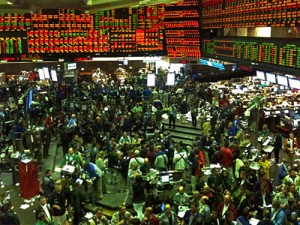 Sugar is not a grain, or a meat commodity – it is regarded as a soft commodity in much the same way as lumber, cocoa, coffee, orange juice and cotton are. Sugar is primarily traded on the ICE exchange (Intercontinental Exchange) and it has the following ticker symbol: SB. However, sugar is also traded on other exchanges around the world, including the Zhengzou Commodity Exchange (CZCE), the National Commodity Exchange Limited (NCEL), the Brazilian Mercantile and Futures Exchange (BF&M), the National Commodities and Derivatives Exchange (NCDEX), and the Kansai Commodities Exchange (KEX).
Sugar is not a grain, or a meat commodity – it is regarded as a soft commodity in much the same way as lumber, cocoa, coffee, orange juice and cotton are. Sugar is primarily traded on the ICE exchange (Intercontinental Exchange) and it has the following ticker symbol: SB. However, sugar is also traded on other exchanges around the world, including the Zhengzou Commodity Exchange (CZCE), the National Commodity Exchange Limited (NCEL), the Brazilian Mercantile and Futures Exchange (BF&M), the National Commodities and Derivatives Exchange (NCDEX), and the Kansai Commodities Exchange (KEX).
Each contract size for sugar is 50 long tonnes or 112,000 pounds. Sugar is delivered in raw sugar cane with 96° of polarization. Sugar contracts are traded in the following months: January, March, May, July and October from Monday through Friday 2:30 am through 3:15 pm Eastern Standard Time. The price of sugar is quoted at $0.0001 cents per pound, and the tick size is 0.01. Traders must meet specific margin requirements to trade sugar as this determines how much outlay is needed for each contract size.
For example a hypothetical sugar futures contract could take the following format: SB15F@13.12 means that the Sugar Contract for 2015 January is trading at $0.1312 per pound. This is precisely the type of format that a sugar trader would purchase a contract. When you are ready to trade sugar contracts on the ICE, the margin requirement is 12%. In the preceding example, the contract size of 112,000 pounds of sugar would cost a trader $14,672. With a 12% margin upfront, the amount needed to make the trade is $1,760.64.
Understanding How Profits are generated with Sugar
For every $0.0001 move in the price of sugar, the total price move for the contract is $11.20. Profits in sugar contracts are easily determined by the difference between the exit price and the contract price. The result is then simply multiplied by $11.20. Presently, the price of sugar is $11.57. The price of sugar is near its 5 year low figure, since it was trading close to $35 in 2011. The price of sugar has consistently declined over the past five years. Prior to the 2011 sugar price surge, trading sugar was well beneath $30, and in fact between late 2006 and 2008 was hovering around the $10 range.
Sugar is primarily available in the form of honey, Maple syrup, sugar beet and sugar cane. Its distinctive characteristic is that it is sweet and this carbohydrate is an instant pick me up by being able to generate rapid energy for the user. The refined form of sugar is white sugar and it comes from sugar beets and sugar cane. Some 78% of global production in sugar comes from sugar cane. This is why it is imperative to follow news updates regarding weather phenomena that impact upon sugarcane production. Shortages of sugar cane lead to price rises in sugar, depending of course on demand and sugar inventories.
The world’s major producers of sugar include Brazil and India, followed by the European Union. What is particularly interesting about this particular commodity is that the majority of sugar is consumed in the country of its production. This is in stark contrast to many other agricultural commodities such as wheat, corn, soy beans, red meat etc. Many countries export the vast majority of their agricultural produce and soft commodities.
Determinants of the Sugar Price
Depending on which country or region we were talking about, demand for sugar will vary considerably. Western societies are moving away from sugar-saturated diets, in favour of sugar substituted diets. This trend is likely to continue as concerns grow about the impact of consuming too much sugar on the general health and well-being of society.
Sugar substitutes are now widely used across the US and Canada, with Europe close in tow. Some of the most pressing concerns with regards to sugar consumption are obesity, diabetes, tooth decay and the like. Even with declining preferences for sugar, the US remains a major consumer of world sugar.
The price of sugar is not free of market manipulation. In the US and many other countries, there are measures in place to protect producers by maintaining artificially high prices. This has the effect of causing consumers to look at alternatives. For example, many food companies are now turning to corn syrup as a substitute sugar. There are growing calls from sugar beet producers and sugar cane producers for a free-market system vis-a-vis sugar prices.
Of course an important determinant of the price of sugar is the quantity of sugar beets and sugar cane. As mentioned, the more abundant these commodities are, the lower the sugar price will be, all things being equal. Adverse weather has a detrimental effect on the production of these crops. Things like frost damage, excessive rains and flooding, droughts and other negative weather phenomena reduce the crop supply and raise the price of sugar on the markets.
It is clear that tariffs and subsidies are widely used to prop up the sugar markets around the world. Nobody knows quite what the real price of sugar should be, since there is so much artificial maintenance of market prices. In truth, the price of sugar may well be substantially less than what it presently is, but the clearest indicators yet of the price of sugar are likely found in things like export numbers, domestic consumption and society’s changing attitudes towards processed sugar.
Tags: Business, Capital, Commodities, investments, money, stock, Sugar, Trading

Recent Comments